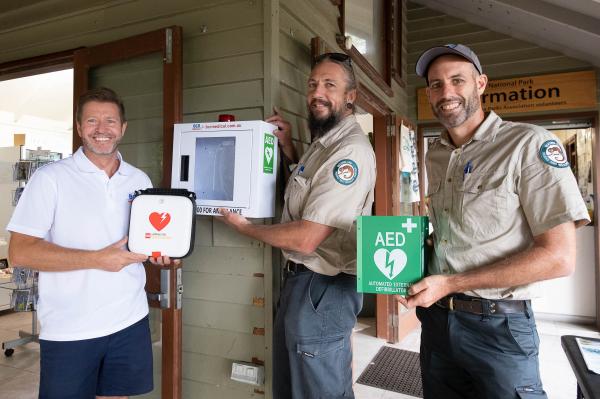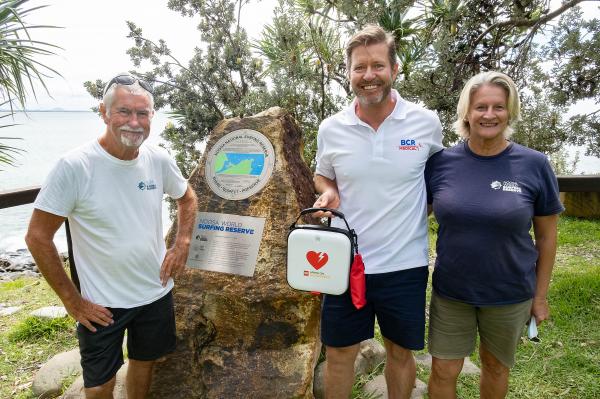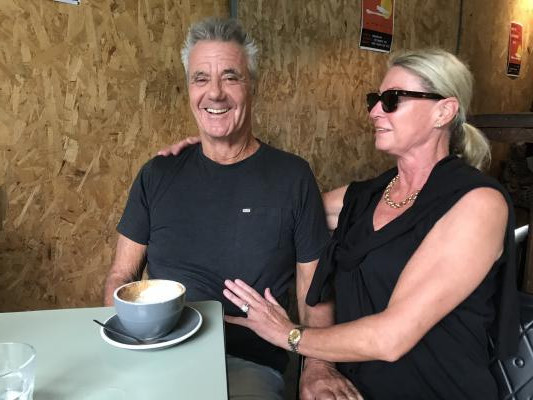
The Friday before Easter started out much like any other day for Noosa surfing retiree Bill McLelland, 67. But by the end of it he would have died, been revived, been airlifted to Sunshine Coast University Hospital and fitted out with a life-saving internal defibrillator.
The lifelong surfer, originally from Merewether Beach in Newcastle, funded a dream Noosa retirement by building up the Hunter region’s biggest and most successful milk run over 30 years, but it very nearly turned into a nightmare for partner Shari. “I cut it pretty bloody fine,” Bill said over a coffee this week. “Without the defib station at the beach I wouldn’t be here.”
Bill could so easily have joined the 30,000 Australians who lose their lives each year through preventable deaths from cardiac arrest. So could veteran kneeboarder Gavin Garps, also 67, who blacked out at First Point in January and was revived by CPR administered by an off-duty policeman, and lifeguard Jack Fray who raced from the tower with a defibrillator.
“Our stories are eerily similar,” Gavin told Noosa Today this week. “We’re both surfers of a certain age who wouldn’t have gotten any older if it wasn’t for a defibrillator on the beach.”
Gavin ended up with a double bypass but is slowly recovering at home and expects to be back in the surf soon. Bill had already had a double bypass four years ago and passed his most recent battery of tests with his cardiologist with flying colours. So on the morning he decided to give the points a miss and paddle out at the beach breaks of Noosa West on his soft-top, he wasn’t expecting anything more than a pleasant session in the friendly little waves on offer.
Bill, a veteran waterman who divides his time between a stand up paddle board and a shortboard, caught a wave to the beach, paddled back out and started a conversation with a fellow surfer while they waited for the next set. For Bill, that next set never came. Without warning he toppled off his board and started to turn blue. He says: “According to my surfing mate, he dragged me about 20 metres to shore and lifeguard Josh Jones saw what was happening from the west tower and raced down the beach with the defib. He gave me four bursts and nothing happened. If they don’t get anything on the fifth it’s all over, red rover, but there was a faint pulse and they got me going from there.”
Bill woke up in a helicopter on his way to SCU Hospital, wondering what the hell had happened. A few days later he was home with his new best friend, an internal defibrillator implanted in his chest which can correct irregular heart rhythms. He expects to be back in the water in about a month.
Two active local seniors who owe their lives to the fast and expert reactions of lifeguard first responders and to the proximity of defibrillator stations. The endings might not have been so happy had these surfers been enjoying their passion for riding waves at the rivermouth or on the point breaks of the outer bays.
Heart experts say that every minute of time lapse between cardiac arrest and defibrillation takes about 12 percent off your chances of survival, so three minutes is considered to be as far as you would want to stretch it. It takes around seven minutes by water for lifeguards to reach Granite Bay. Without defibrillation the cardiac arrest survival rate outside of hospitals is less than 10 percent, and around one percent in water.
This is why the Noosa World Surfing Reserve, in partnership with Queensland Parks and Wildlife and BCR Medical, national distributors of the Lifepak CR2 defibrillator kits, last week installed the first of a projected five defibrillators outside the Noosa Parks Association information centre and kiosk adjacent to the National Park surf break. The NWSR is negotiating with Parks and Wildlife about the placement of a defib between Tea Tree and Granite Bays to bring both within that crucial three-minute time frame, and with Noosa Council about placements at Noosa Woods behind West Beach.
Said NWSR stewardship council’s Di Cuddihy: “Of course these stations are not just for surfers. There are so many different kinds of park users out on the headland and at The Woods, and all stand to benefit.”
The first station in the National Park was donated by BCR Medical, through its local agent and surfer Brett Roche. Mr Roche said: “We’re delighted to work alongside the Noosa World Surfing Reserve, as we do with our many corporate clients around the country, to help reduce the number of preventable deaths from cardiac arrest. And, of course, as a surfer I’m stoked to be making our sport safer for everyone.”
The NWSR is looking for funding assistance to complete its defibrillator program, so if you or your business would like to “Adopt a Defib” please email info@noosaworldsurfingreserve.com.au. For information about BCR’s range of defibrillator products contact Brett Roche at admin@bcrmedical.com.au or visit www.bcrmedical.com.au








